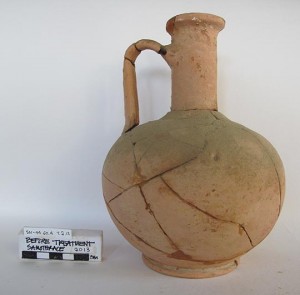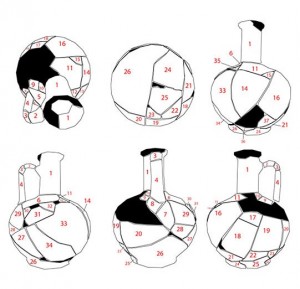Shading the Shellac: Drawing for Conservation
As conservators, we examine objects in all kinds of ways: we touch, we smell, we tap with bamboo skewers. But seldom do we actually draw the objects we treat. In general, high-resolution photography serves as our visual documentation.
My classmate Kate Brugioni and I were delighted to discover that Samothracian objects often benefit from a drawing or digital diagram in addition to photography. Since we are usually re-treating previously reconstructed ceramics and glass, creating a drawing can be a very useful way to articulate how the object has changed since it was found in the Sanctuary.
For example, I recently began treating a ceramic vessel discovered in the South Nekropolis during the 1957 excavation season. Since conservation on Samothrace predates the invention of stable synthetic resins, early conservators often used shellac to reassemble broken fragments. Unfortunately, shellac (an adhesive made from crushed insect shells) is a disfiguring dark brown color and will grow increasingly brittle over time. I will remove the shellac currently holding the vessel together and reassemble it using an inert, removable adhesive known as Acryloid B72.  Using Photoshop, I created drawings which outline and number the fragments present in the vessel. As I puzzle the pieces back together, the drawings will act as a road map, a pathway from parts to whole.
Using Photoshop, I created drawings which outline and number the fragments present in the vessel. As I puzzle the pieces back together, the drawings will act as a road map, a pathway from parts to whole. These are not precise archaeological drawings like the lion’s head water spout from the Milesian dedication (see blog post “When it Rains it Roars”). Yet both types of drawings compensate in different ways for the shortcomings of photography. Where the archaeological drawing emphasizes the features salient to the archaeologist, the conservation drawing emphasizes the features salient to the conservator.
These are not precise archaeological drawings like the lion’s head water spout from the Milesian dedication (see blog post “When it Rains it Roars”). Yet both types of drawings compensate in different ways for the shortcomings of photography. Where the archaeological drawing emphasizes the features salient to the archaeologist, the conservation drawing emphasizes the features salient to the conservator.
The experience of drawing, the act of taking pen to paper or cursor to screen, is just as useful as the drawings themselves. Bringing a three dimensional form into two dimensions gives the drawer a special familiarity with the object. It is an intimacy not unlike the intimacy which once existed between the ancient potter and the clay.
